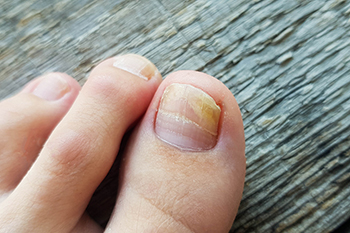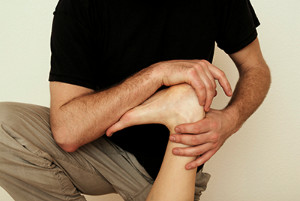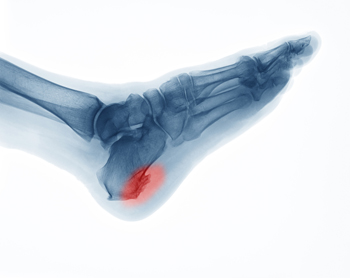Items filtered by date: May 2023
Ways to Avoid Toenail Fungus Infections

The toenails are easily ignored when thinking about basic healthcare, but there are many simple ways to keep them pain and problem free. Probably the two most common ailments are ingrown toenails and toenail fungus. An ingrown toenail is usually the result of the nail being cut incorrectly. It is suggested that cutting toenails straight across and not too short can prevent the nail from growing into the nail bed rather than over it. Fungal infections of the toenails can easily be spread in warm and moist areas, such as gym locker rooms and indoor swimming pools. Wearing protective foot coverings is a good way to prevent this annoying infection. Fungal toenail infections are extremely contagious, so it’s wise to keep from touching the infected area. If you have toenail fungal infections that recur, even after applying commercial anti-fungal remedies, it is a good idea to make an appointment with a podiatrist who can prescribe more powerful medication. In addition, trying to fix an ingrown toenail can lead to a bacterial infection. It is suggested that you make an appointment with a podiatrist who can safely deal with the problem.
If left untreated, toenail fungus may spread to other toenails, skin, or even fingernails. If you suspect you have toenail fungus it is important to seek treatment right away. For more information about treatment, contact one of our podiatrists of Florida Ankle & Foot Institute. Our doctors can provide the care you need to keep you pain-free and on your feet.
Symptoms
- Warped or oddly shaped nails
- Yellowish nails
- Loose/separated nail
- Buildup of bits and pieces of nail fragments under the nail
- Brittle, broken, thickened nail
Treatment
If self-care strategies and over-the-counter medications does not help your fungus, your podiatrist may give you a prescription drug instead. Even if you find relief from your toenail fungus symptoms, you may experience a repeat infection in the future.
Prevention
In order to prevent getting toenail fungus in the future, you should always make sure to wash your feet with soap and water. After washing, it is important to dry your feet thoroughly especially in between the toes. When trimming your toenails, be sure to trim straight across instead of in a rounded shape. It is crucial not to cover up discolored nails with nail polish because that will prevent your nail from being able to “breathe”.
In some cases, surgical procedure may be needed to remove the toenail fungus. Consult with your podiatrist about the best treatment options for your case of toenail fungus.
If you have any questions, please feel free to contact our offices located in Tavernier, Marathon, and Key West, FL . We offer the newest diagnostic and treatment technologies for all your foot care needs.
Gout Pain Can Be Managed
How Stretches Can Benefit the Feet

Given the many sources of pain and tightness our feet can endure in life, it behooves us to take regular care of our feet, including stretching them. Moving around in daily life, airplane flights, long car rides, and vigorous exercise can all impact the comfort of our feet. Painful, swollen feet can lead to pain above the feet as well, including the ankles, knees, hips, and back. Stretches can be performed to soothe the feet, improve flexibility, and help with circulation. A few examples of foot stretches include the point and flex exercise, the foot prayer, and the inner ankle stretch. The point and flex exercise is done while sitting on the floor or a workout bench with the feet pointed out in front of you. From this position, point and flex the feet and toes repeatedly. The foot prayer consists of sitting in the same position and then rotating the feet inward, bringing the soles of the feet together. Hold for three seconds before straightening the legs out and repeating. The inner ankle stretch also starts with the feet pointed out in front of you and the feet flexed. The feet should then be rotated outward until a gentle stretch is felt in the inner ankle and foot. As with the prior exercise, stretching should be held for three seconds and repeated. If you regularly suffer from foot pain or tightness and want more information on stretches you can do for your feet, it is suggested that you consult with a podiatrist for further discussion on this issue.
Stretching the feet is a great way to prevent injuries. If you have any concerns with your feet consult with one of our podiatrists from Florida Ankle & Foot Institute. Our doctors will assess your condition and provide you with quality foot and ankle treatment.
Stretching the Feet
Being the backbone of the body, the feet carry your entire weight and can easily become overexerted, causing cramps and pain. As with any body part, stretching your feet can serve many benefits. From increasing flexibility to even providing some pain relief, be sure to give your feet a stretch from time to time. This is especially important for athletes or anyone performing aerobic exercises, but anyone experiencing foot pain or is on their feet constantly should also engage in this practice.
Great ways to stretch your feet:
- Crossing one leg over the others and carefully pull your toes back. Do 10-20 repetitions and repeat the process for each foot
- Face a wall with your arms out and hands flat against the wall. Step back with one foot and keep it flat on the floor while moving the other leg forward. Lean towards the wall until you feel a stretch. Hold for 30 seconds and perform 10 repetitions for each foot
- Be sure not to overextend or push your limbs too hard or you could risk pulling or straining your muscle
Individuals who tend to their feet by regular stretching every day should be able to minimize foot pain and prevent new problems from arising.
If you have any questions, please feel free to contact our offices located in Tavernier, Marathon, and Key West, FL . We offer the newest diagnostic and treatment technologies for all your foot care needs.
Is a Heel Spur Painful?

A small, hard growth that develops on the underside of the heel may be a heel spur. It is defined as a calcium deposit and extends between the arch and the heel. Some heel spurs can be up to a half inch long, and may or may not be painful. Some of the symptoms that are associated with a heel spur are swelling surrounding the heel, the skin feeling warm when touched, and being inflamed. The cause of a heel spur is muscle and ligament strain, and can gradually develop as the aging process occurs. They may also happen from wearing shoes that are worn out, having excess body weight, or if there is an abnormal foot structure. An X-ray is often taken that can confirm a heel spur, and can be treated through adequate rest and lifestyle changes. It may be beneficial to perform gentle stretches that can help to strengthen the muscles. If you feel pain or mild discomfort in your heel, it is suggested that you speak with a podiatrist who can accurately diagnose and treat heel spurs.
Heel spurs can be incredibly painful and sometimes may make you unable to participate in physical activities. To get medical care for your heel spurs, contact one of our podiatrists from Florida Ankle & Foot Institute. Our doctors will do everything possible to treat your condition.
Heels Spurs
Heel spurs are formed by calcium deposits on the back of the foot where the heel is. This can also be caused by small fragments of bone breaking off one section of the foot, attaching onto the back of the foot. Heel spurs can also be bone growth on the back of the foot and may grow in the direction of the arch of the foot.
Older individuals usually suffer from heel spurs and pain sometimes intensifies with age. One of the main condition's spurs are related to is plantar fasciitis.
Pain
The pain associated with spurs is often because of weight placed on the feet. When someone is walking, their entire weight is concentrated on the feet. Bone spurs then have the tendency to affect other bones and tissues around the foot. As the pain continues, the feet will become tender and sensitive over time.
Treatments
There are many ways to treat heel spurs. If one is suffering from heel spurs in conjunction with pain, there are several methods for healing. Medication, surgery, and herbal care are some options.
If you have any questions feel free to contact our offices located in Tavernier, Marathon, and Key West, FL . We offer the latest in diagnostic and treatment technology to meet your needs.
Benefits of Becoming a Podiatrist

The job of a podiatrist is to treat foot conditions. These can include bunions, hammertoes, or a multitude of ailments that affect the lower extremities. A benefit of choosing podiatry as a career can be a desirable work-life balance. This may be a result of having limited emergencies and a predictable work schedule. The education requirements to become a podiatrist begins with obtaining a bachelor's degree, followed by enrolling in an accredited podiatry school. This will earn the potential doctor a degree that is called Doctor of Podiatric Medicine, or DPM. This will take four years to complete, and courses such as biology, anatomy, and pathology will be taught. After this is completed, a residency program begins for three years, giving the candidate an opportunity to interact with patients. People who are interested in pursuing a career in podiatry are urged to speak with this type of doctor, who can help them determine if this is a right choice for them.
If you are dealing with pain in your feet and ankles, you may want to seek help from a podiatrist. Feel free to contact one of our podiatrists from Florida Ankle & Foot Institute. Our doctors can provide the care you need to keep you pain-free and on your feet.
What Is a Podiatrist?
A podiatrist is a doctor of podiatric medicine who diagnoses and treats conditions of the foot, ankle, and related structures of the leg. Your podiatrist may specialize in a certain field such as sports medicine, wound care, pediatrics, and diabetic care. Podiatrists have the ability to become board certified through training, clinical experience, and then taking an exam.
What Do Podiatrists Do?
On a daily basis, a podiatrist may perform the following activities:
- Diagnose foot ailments such as ulcers, tumors, fractures, etc.
- Use innovative methods to treat conditions
- Use corrective orthotics, casts, and strappings to correct deformities
- Correct walking patterns and balance
- Provide individual consultations to patients
It is very important that you take care of your feet. It’s easy to take having healthy feet for granted, however foot problems tend to be among the most common health conditions. Podiatrists can help diagnose and treat a variety of feet related conditions, so it is crucial that you visit one if you need assistance.
If you have any questions please feel free to contact our offices located in Tavernier, Marathon, and Key West, FL . We offer the newest diagnostic and treatment technologies for all your foot and ankle needs.
Symptoms of Athlete’s Foot

Athlete’s foot, or tinea pedis, is a common fungal infection that causes redness, itching, and flakiness. The skin may also begin to crack between the toes and on the soles of the feet. Additionally, changes in skin color and a foul smell may accompany athlete’s foot. One does not have to be an athlete to get athlete’s foot. This ailment got its name from being common among athletes who frequent gyms and locker rooms, that are breeding grounds for athlete’s foot fungus. Anyone can get athlete’s foot, and the chances may increase with a weakened immune system, poor foot hygiene, or possibly from diabetes. This condition is contagious, and can be spread through contact with infected skin or through indirect contact with clothing, towels, or floors. It is beneficial for athlete’s foot to be treated promptly, and if left untreated, it may become worse, and affect the toenails. If you have athlete’s foot, it is suggested that you consult with a podiatrist who can provide you with treatment and prevention methods.
Athlete’s Foot
Athlete’s foot is often an uncomfortable condition to experience. Thankfully, podiatrists specialize in treating athlete’s foot and offer the best treatment options. If you have any questions about athlete’s foot, consult with one of our podiatrists from Florida Ankle & Foot Institute. Our doctors will assess your condition and provide you with quality treatment.
What Is Athlete’s Foot?
Tinea pedis, more commonly known as athlete’s foot, is a non-serious and common fungal infection of the foot. Athlete’s foot is contagious and can be contracted by touching someone who has it or infected surfaces. The most common places contaminated by it are public showers, locker rooms, and swimming pools. Once contracted, it grows on feet that are left inside moist, dark, and warm shoes and socks.
Prevention
The most effective ways to prevent athlete’s foot include:
- Thoroughly washing and drying feet
- Avoid going barefoot in locker rooms and public showers
- Using shower shoes in public showers
- Wearing socks that allow the feet to breathe
- Changing socks and shoes frequently if you sweat a lot
Symptoms
Athlete’s foot initially occurs as a rash between the toes. However, if left undiagnosed, it can spread to the sides and bottom of the feet, toenails, and if touched by hand, the hands themselves. Symptoms include:
- Redness
- Burning
- Itching
- Scaly and peeling skin
Diagnosis and Treatment
Diagnosis is quick and easy. Skin samples will be taken and either viewed under a microscope or sent to a lab for testing. Sometimes, a podiatrist can diagnose it based on simply looking at it. Once confirmed, treatment options include oral and topical antifungal medications.
If you have any questions, please feel free to contact our offices located in Tavernier, Marathon, and Key West, FL . We offer the newest diagnostic and treatment technologies for all your foot care needs.




